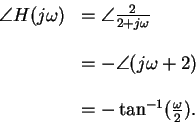The frequency response function is complex-valued,
it is convenient to write it in polar form:
In our RC example, the frequency response function is


The Bode diagrams show magnitude and phase as functions of frequency,
usually plotted using a logarithmic scale for the frequency axis
(x-axis).
Phase angle is plotted in a linear scale (y-axis), see
Figure 49.
However, magnitude can vary greatly, and a special
logarithmic scale called the decibel scale is used.
Given a real number R, the value of R in
decibels is defined by
From our calculations we have
The frequency at which the magnitude is 3 dB less than the
maximum is called the 3 dB point.
We can find it as follows. Set
ANU Engineering - ENGN2211